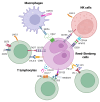Metabolic Interactions in the Tumor Microenvironment of Classical Hodgkin Lymphoma: Implications for Targeted Therapy
- PMID: 40806636
- PMCID: PMC12346973
- DOI: 10.3390/ijms26157508
Metabolic Interactions in the Tumor Microenvironment of Classical Hodgkin Lymphoma: Implications for Targeted Therapy
Abstract
Classical Hodgkin lymphoma (cHL) is a biologically and clinically unique malignancy characterized by rare Hodgkin and Reed-Sternberg (HRS) cells surrounded by a dense and diverse inflammatory infiltrate. These malignant cells actively reshape the tumor microenvironment (TME) through metabolic reprogramming and immune evasion strategies. This review synthesizes current knowledge on how metabolic alterations contribute to tumor survival, immune dysfunction, and therapeutic resistance in cHL. We discuss novel therapeutic approaches aimed at disrupting these processes and examine the potential of combining metabolic interventions with immune-based strategies-such as immune checkpoint inhibitors (CPIs), epigenetic modulators, bispecific antibodies, and CAR-T/CAR-NK cell therapies-which may help overcome resistance and enhance anti-tumor responses. Several agents are currently under investigation for their ability to modulate immune cell metabolism and restore effective immune surveillance. Altogether, targeting metabolic vulnerabilities within both tumor and immune compartments offers a promising, multifaceted strategy to improve clinical outcomes in patients with relapsed or refractory cHL.
Keywords: Hodgkin lymphoma; cell metabolism; therapeutic strategies; tumor microenvironment.
Conflict of interest statement
The authors declare no conflicts of interest.
Figures


References
-
- Aggarwal P., Limaiem F. Brenner’s Encyclopedia of Genetics. 2nd ed. Elsevier Science; Amsterdam, The Netherlands: 2025. Reed-Sternberg Cells; pp. 113–115. - DOI
Publication types
MeSH terms
Substances
LinkOut - more resources
Full Text Sources
Medical

